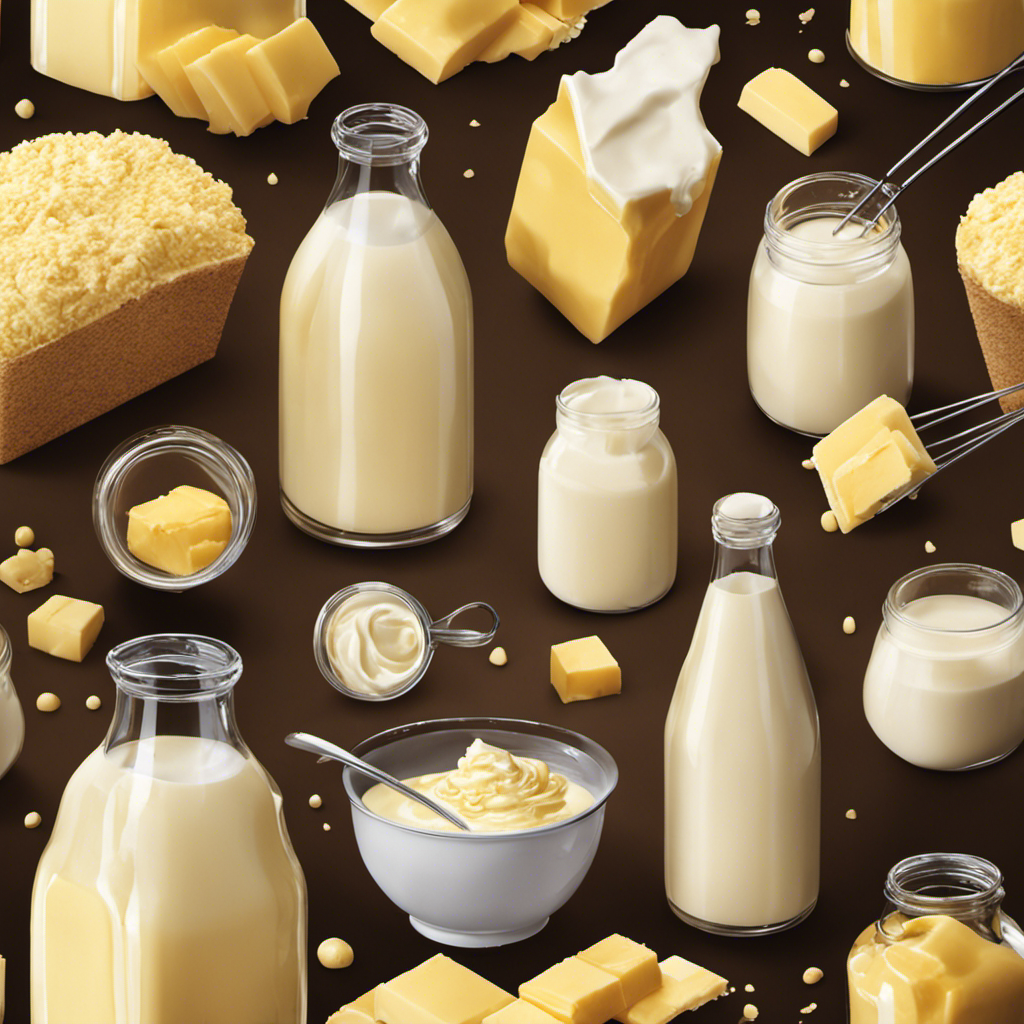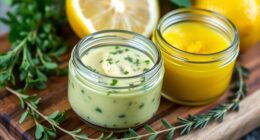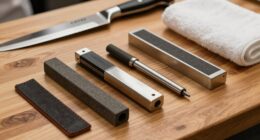I have found the key to keeping cuticles perfectly pampered: butter cuticle exfoliator!
In this informative guide, I’ll show you how to effectively use this nourishing product to achieve healthy and beautiful nails.
By following my step-by-step instructions, you’ll learn the techniques for massaging the exfoliator into your cuticles, how often to use it, and tips for maximizing its effectiveness.
Get ready to say goodbye to dry and rough cuticles, and hello to a long-lasting manicure that will leave you feeling confident and polished.
Key Takeaways
- Butter cuticle exfoliator removes dead skin cells and dirt from cuticles.
- It promotes healthy nail growth by stimulating blood circulation.
- The exfoliator provides intense hydration to prevent dryness and cracking.
- Regular use of butter cuticle exfoliator leaves cuticles smooth and healthy-looking.
Benefits of Using Butter Cuticle Exfoliator
Using a butter cuticle exfoliator will help you soften and nourish your cuticles. The benefits of using a butter cuticle exfoliator are numerous.
Firstly, it helps to remove dead skin cells and dirt that can accumulate on the cuticles, leaving them smooth and healthy-looking. It also promotes healthy nail growth by stimulating blood circulation to the nail bed. Additionally, the butter in the exfoliator provides intense hydration, preventing dryness and cracking of the cuticles.
When it comes to application techniques, start by washing your hands and drying them thoroughly. Apply a small amount of the butter cuticle exfoliator to each cuticle and gently massage in a circular motion for about a minute. This will ensure that the product is evenly distributed and absorbed. Rinse off the excess with warm water and pat dry.
Now that you know the benefits and application techniques of using a butter cuticle exfoliator, let’s move on to preparing your nails for exfoliation.
Preparing Your Nails for Exfoliation
When it comes to nail cleaning techniques, there are a few key points to keep in mind.
Firstly, it’s important to properly clean your nails to remove any dirt or debris that may be trapped underneath.
Secondly, exfoliation can offer numerous benefits for your nails, such as promoting healthy growth and preventing ingrown nails.
Lastly, choosing the right tools for exfoliation is crucial, whether it’s a gentle nail brush or a specialized exfoliating tool.
Nail Cleaning Techniques
One way to clean your nails is by gently rubbing the butter cuticle exfoliator onto the nail bed. This technique not only removes dirt and grime, but also helps to promote nail health. The butter cuticle exfoliator contains nourishing ingredients that moisturize and soften the cuticles, making them easier to push back and trim. To ensure a thorough clean, I recommend using a soft nail brush to gently scrub the exfoliator into the nails and cuticles. This will help to remove any dead skin cells or residue, leaving your nails looking clean and healthy. Here is a table that highlights the benefits of DIY nail care:
| Benefits of DIY Nail Care |
|---|
| Saves money |
| Allows for personalization |
| Promotes healthy nail growth |
Exfoliation Benefits Explained
To fully understand the benefits of exfoliation, you should know that it helps remove dead skin cells and promotes healthier nails.
Exfoliating nails not only improves their appearance but also enhances their overall health. By gently sloughing off dead skin cells, exfoliation stimulates blood circulation, allowing for better nutrient delivery to the nail bed. This, in turn, promotes the growth of stronger and healthier nails.
Additionally, exfoliating can help prevent and treat common nail issues such as dryness, brittleness, and yellowing.
To achieve the best results, it is essential to use proper exfoliation techniques. This involves using a gentle exfoliating product, such as a butter cuticle exfoliator, and massaging it onto the nails and surrounding cuticles in circular motions.
Regular exfoliation, combined with proper nail care, can significantly improve the condition and appearance of your nails.
Best Tools for Exfoliation
The best tools for exfoliation include gentle scrubs and brushes that effectively remove dead skin cells. Regular exfoliation not only helps to unclog pores and prevent breakouts, but it also promotes cell turnover, revealing smoother and brighter skin.
Here are three sub-lists to help you choose the best exfoliation tools and understand the benefits of regular exfoliation:
-
Scrubs:
-
Look for scrubs with natural exfoliants like sugar or salt to gently buff away dead skin.
-
Avoid harsh scrubs with large particles that can cause micro-tears in the skin.
-
Opt for scrubs with added moisturizing ingredients like oils or butters to nourish the skin.
-
Brushes:
-
Consider using a soft bristle brush to manually exfoliate the skin.
-
Brushes with long handles are great for reaching the back and other hard-to-reach areas.
-
Look for brushes made from natural fibers or silicone for a gentle yet effective exfoliation.
-
Benefits of regular exfoliation:
-
Improves skin texture and tone.
-
Enhances the absorption of skincare products.
-
Helps to reduce the appearance of fine lines and wrinkles.
Choosing the Right Butter Cuticle Exfoliator
When it comes to choosing the right butter cuticle exfoliator, there are a few key points to consider.
First, it’s important to take a look at the ingredients list. Look for natural and nourishing ingredients like shea butter, coconut oil, and vitamin E, as these will help to moisturize and protect your cuticles.
Next, consider the different application methods available. Some exfoliators come in a cream or balm form, while others may be in a scrub or oil form.
Ingredients to Consider
Make sure you check the label for any potential allergens or irritants in the butter cuticle exfoliator. When considering ingredients in a butter cuticle exfoliator, it’s important to understand their effectiveness in achieving smooth and healthy cuticles.
Here are some key ingredients to look for:
- Shea Butter: Known for its moisturizing properties, shea butter helps nourish and soften the cuticles, making them easier to exfoliate.
- Jojoba Oil: With its similarity to the natural oils produced by our skin, jojoba oil helps balance moisture levels and promotes a healthy cuticle environment.
- Vitamin E: This antioxidant ingredient not only provides hydration but also helps protect the cuticles from environmental damage.
By understanding the effectiveness of these ingredients, you can choose a butter cuticle exfoliator that will effectively improve the condition of your cuticles.
Now, let’s explore the different application methods for maximum benefits.
Different Application Methods
Now that we have discussed the key ingredients to look for in a butter cuticle exfoliator, let’s move on to different application techniques.
There are several ways you can apply a butter cuticle exfoliator to achieve smooth and healthy cuticles. One common method is to simply massage the exfoliator onto your cuticles using circular motions. This helps to remove dead skin cells and promote blood circulation, resulting in softer cuticles.
Another technique is to soak your hands in warm water for a few minutes prior to applying the exfoliator. This will help soften the cuticles and make the exfoliation process more effective.
If you prefer alternative exfoliation methods, you can also try using a soft toothbrush or a cuticle pusher to gently scrub away the dead skin. Just be careful not to apply too much pressure to avoid damaging your cuticles.
Now that we know how to apply a butter cuticle exfoliator, let’s move on to the next step – finding the right brand that suits your needs.
Finding the Right Brand
To find the right brand for you, consider researching customer reviews and asking for recommendations from friends or beauty professionals. It’s important to understand the different options available when choosing a brand of butter cuticle exfoliator.
Here are some tips to help you make an informed decision:
-
Look for brands that use natural ingredients: Some butter cuticle exfoliators may contain harsh chemicals that can irritate your skin. Opt for brands that prioritize natural and organic ingredients.
-
Consider your skin type: Different brands may cater to specific skin types. If you have sensitive skin, look for a brand that offers a gentle formula. If you have dry or cracked cuticles, choose a brand that provides intense hydration.
-
Check for additional benefits: Some brands may offer added benefits like nail strengthening or anti-aging properties. Consider what other features you may want from your butter cuticle exfoliator.
Step-by-Step Guide to Using Butter Cuticle Exfoliator
First, you’ll want to gently massage the butter cuticle exfoliator onto your cuticles in circular motions to remove any dead skin cells. Before applying the exfoliator, it’s important to prepare your cuticles by soaking them in warm water for a few minutes. This will help soften the skin and make the exfoliation process more effective.
Regular exfoliation of the cuticles has several benefits. It helps to promote healthy nail growth by stimulating blood circulation to the area. It also helps to prevent hangnails and protects against infections. By removing dead skin cells, the exfoliator allows for better absorption of moisturizers and cuticle oils, leaving your cuticles soft and smooth.
Now that you’ve applied the butter cuticle exfoliator, let’s explore some techniques for massaging it into your cuticles.
Techniques for Massaging the Exfoliator Into Your Cuticles
Once you’ve applied it, gently massage the exfoliator into your cuticles using small circular motions. This massage technique not only helps to remove dead skin cells and impurities, but also promotes blood circulation and stimulates the growth of healthy cuticles.
Here are some benefits of regular exfoliation and how to enhance your experience:
-
Enhanced relaxation: Take a moment to close your eyes and focus on the sensation of the exfoliator on your cuticles. This can help you relax and unwind.
-
Increased absorption: By exfoliating regularly, you’ll remove any barriers on the surface of your cuticles, allowing moisturizers and oils to penetrate more effectively.
-
Improved nail health: Regular exfoliation can prevent dryness, cracking, and peeling, promoting stronger and healthier nails.
By incorporating these massage techniques into your cuticle care routine, you can enjoy the full benefits of regular exfoliation.
Now, let’s explore how often you should use butter cuticle exfoliator.
How Often Should You Use Butter Cuticle Exfoliator
Now that you know how to massage the butter cuticle exfoliator into your cuticles, let’s discuss how often you should incorporate this product into your nail care routine.
Exfoliating your cuticles is an important step in maintaining healthy and beautiful nails. However, it’s essential to strike a balance and not overdo it.
Experts recommend exfoliating your cuticles once or twice a week. This frequency allows for the removal of dead skin cells and promotes healthy nail growth without causing damage or irritation. Over-exfoliating can lead to dryness, redness, and even thinning of the cuticles. It’s important to pay attention to your skin’s response and adjust the frequency accordingly.
Incorporating the butter cuticle exfoliator into your nail care routine on a regular basis will help keep your cuticles in top shape, ensuring that your nails look their best.
Tips for Maximizing the Effectiveness of the Exfoliator
To get the most out of the exfoliator, it’s important to follow the recommended frequency and pay attention to your skin’s response. Here are some tips for maximizing the effectiveness of the exfoliator:
-
Start with a clean face: Before using the exfoliator, make sure to cleanse your face thoroughly to remove any dirt or makeup. This will allow the exfoliator to penetrate deeper into your skin and provide better results.
-
Use gentle circular motions: When applying the exfoliator, use gentle circular motions to massage it into your skin. This will help to remove dead skin cells and unclog your pores more effectively.
-
Don’t overdo it: While exfoliating is important, it’s also important not to overdo it. Exfoliating too frequently can irritate your skin and cause redness or dryness. Follow the recommended frequency for your specific skin type to avoid any negative effects.
By following these tips, you can maximize the results of your exfoliator and achieve smoother, healthier-looking skin.
Now, let’s move on to the next step: following up with moisturizing and nourishing products.
Following up With Moisturizing and Nourishing Products
After exfoliating, it’s essential to moisturize and nourish your skin to keep it hydrated and healthy. Moisturizing is key to replenishing the skin’s moisture barrier and preventing dryness. Look for moisturizers that are lightweight and non-comedogenic, so they won’t clog your pores. Apply the moisturizer immediately after exfoliating while your skin is still slightly damp to lock in the moisture.
When it comes to nourishing techniques, consider using products that contain ingredients like hyaluronic acid, glycerin, and ceramides, as they help to hydrate and repair the skin. Additionally, incorporating facial oils into your skincare routine can provide an extra boost of nourishment. Massage a few drops onto your face and neck after moisturizing to seal in the moisture and promote a healthy glow.
The Long-Term Benefits of Regular Cuticle Exfoliation
Regularly exfoliating your cuticles not only promotes healthier nails, but it also helps to prevent hangnails and allows for better absorption of cuticle oils and creams. Taking care of your cuticles is essential for maintaining strong and beautiful nails in the long run.
Here are some of the key benefits of regular cuticle exfoliation:
-
Improved Nail Health:
-
Exfoliating removes dead skin cells, improving the overall health of your nails.
-
It keeps the cuticles moisturized, preventing dryness and cracking.
-
Prevention of Hangnails:
-
By removing excess skin and hangnails, exfoliation minimizes the risk of painful hangnails.
-
Enhanced Nail Product Absorption:
-
Exfoliating your cuticles allows for better absorption of cuticle oils and creams, maximizing their effectiveness.
Incorporating cuticle exfoliation into your nail care routine can have significant long-term effects, resulting in healthier, stronger nails and preventing common nail problems.
Frequently Asked Questions
Can I Use Butter Cuticle Exfoliator on My Toenails?
Yes, you can use Butter Cuticle Exfoliator on your toenails. It is a great way to take care of your toenails and enjoy the benefits of using cuticle exfoliators.
Is Butter Cuticle Exfoliator Safe for Sensitive Skin?
Yes, butter cuticle exfoliator is safe for sensitive skin. It gently removes dead skin cells and moisturizes the cuticles. If you’re looking for alternatives, try natural oils like coconut or almond oil.
Can I Use Butter Cuticle Exfoliator if I Have Acrylic or Gel Nails?
Yes, you can use butter cuticle exfoliator with acrylic or gel nails. It is safe and gentle on natural nails. Regular use of butter cuticle exfoliator can help keep your nails and cuticles healthy and moisturized.
How Long Should I Leave the Butter Cuticle Exfoliator on My Nails Before Rinsing It Off?
I recommend leaving the butter cuticle exfoliator on your nails for about 3-5 minutes before rinsing it off. However, it should not be used on damaged or infected nails.
Can I Use Butter Cuticle Exfoliator if I Have a Cut or Open Wound on My Fingers?
Using butter cuticle exfoliator on broken skin may cause further irritation and delay healing. It’s best to avoid applying it directly on open wounds. However, using it on healthy nails can provide numerous benefits for nail health.
Conclusion
In conclusion, using butter cuticle exfoliator can greatly benefit the health and appearance of your nails. By regularly exfoliating your cuticles, you can remove dead skin cells and promote healthy nail growth.
Remember to choose a high-quality butter cuticle exfoliator and follow the step-by-step guide for the best results. Massaging the exfoliator into your cuticles using various techniques will enhance the effectiveness of the product.
Additionally, moisturizing and nourishing your nails after exfoliation will further enhance their health and appearance. So why wait? Start incorporating butter cuticle exfoliator into your nail care routine today for long-term benefits.









